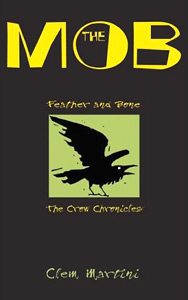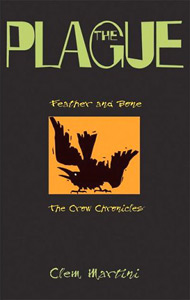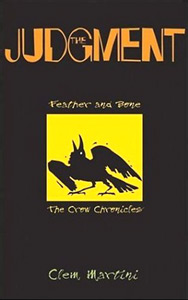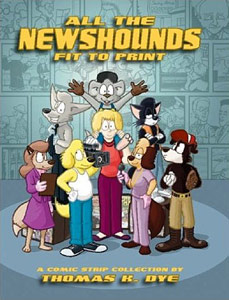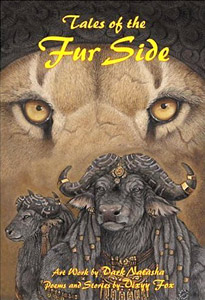 |
|
|
| Title: |
Tales of the Fur Side |
| Author: |
Vixyy Fox |
| Illustrator: |
Dark Natasha |
| Publisher: |
United Publications (Keston, Kent, UK), Jun 2006 |
| ISBN: |
0-9537847-4-6 |
|
Trade Paperback, 187 pages, USD $9.99/Brit £6.99 |
|
|
Editor’s note: In addition to being available from Amazon.com, you can also buy Tales of the Fur Side directly from the publisher, United Publications, or from the author herself.
The exact credits upon the title page read: Art Work by Dark Natasha; Poems and Stories by Vixyy Fox. Dark Natasha (Natasha Mleynek) is given priority as the creator because her thirty illustrations, most full-page, are the inspiration for the stories and poems written around them. Many of the illustrations, as full-color paintings and art prints, have been favorites at convention art shows for several years. As prints, they (and hundreds more) may also be seen and bought at the artist’s website.
In a poetic Foreword, Vixyy Fox explains that the collaborators have never met in person: Dark Natasha has never met me, nor I her… our communication [is] only through the ethers of ‘The Cyber’. As I gaze into that clear pool, I see her as my reflection… we co-exist, but in different dimensions. I fear that if we were to ever touch, the spell would be broken, and we would never have each other again. (pg. 5) On her own website (where Tales of the Fur Side was previously available as an electronic book), she explains further (in the third person) that her Furry persona was born when she saw a picture by Dark Natasha of an anthropomorphic fennec: Vixyy Fox was born of the internet. In one brief moment of need, she was there to comfort, heal, and teach. (The typist is only her tool.) She loves to create, and writes in as many different styles as meets her whims. She will view an image created by her muse Dark Natasha, and the story flows with a life of it's own. Through her, the typist does not write… but simply watches and records. Many of the stories are written with an adult sexual sensibility, especially those with African tribal settings, and are not intended for children.
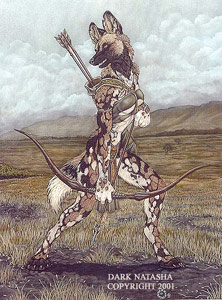 Tales of the Fur Side contains thirteen stories and nine poems. Each is illustrated with the picture(s) upon which it is based. The stories and poems are bookended by a Bob and the Devil prologue and epilogue, in which two identical old men both named Bob, obviously God and the Devil, play games of chess for the fate of mortals; but this time, “We play animalkind in stead [sic.] of mankind like in the other games.” (pg. 12)
Tales of the Fur Side contains thirteen stories and nine poems. Each is illustrated with the picture(s) upon which it is based. The stories and poems are bookended by a Bob and the Devil prologue and epilogue, in which two identical old men both named Bob, obviously God and the Devil, play games of chess for the fate of mortals; but this time, “We play animalkind in stead [sic.] of mankind like in the other games.” (pg. 12)
Since one of Dark Natasha’s specialties is painting animals in appropriate ethnic garb (North American foxes and wolves in Native American costumes; African animals in African tribal dress), many of the stories are appropriately themed. One of the longest stories, Family of the Heart (pages 30–65), about a group of enslaved African animals (Narka the Zebra Taur warrior, Saloni the Zebra girl, two Cheetah sisters, Anoma the old Hyena, Simbawoo and Simbawaa the Water Buffalo mystics, and assorted Gazelles, among others) who work together to escape the slaver The Black Robe (Lion), is crafted around six African-animal interior illustrations and the book’s front and back covers. Anuee of the Plains is a shorter, similar story featuring Cape hunting dogs and Gibbons. In Mama, an African fennec fox teaches Toby, her reckless kit, a basic survival lesson.
Despite the ‘animalkind in stead of mankind’ rule, there are people in several stories. The Quiet One and Wolfen, with North American settings, feature humans who discover Native American shapeshifters or hidden native animal-people communities. Toth is about the meeting of a British Egyptologist and his daughter with the jackal-headed son of Anubis. Ga Fueten presents the final deadly confrontation between a Norse warrior and ‘The wolf who walks As a man’. Two stories seem to gently parody furry fandom: Anastasia: Painter of People, is about a vixen-artist who has secretly painted a forbidden picture of imaginary ‘people’ in an animal society where they are considered a perverse sexual fantasy: People are not a species at all, but a mythical beast, part fur, and part something else. I have heard the word monkey bandied about, but they are smooth skinned… not furry like us, or monkeys. (pg. 80) Puppy Love, the only comedy in the book, is the ‘confession’ of Waldo, a large stray dog who is sure that he is really a cat trapped in a canine body. Waldo becomes ostracized by other renegade dogs after he starts washing himself like a cat and coughing up hairballs, but all ends happily when he is finally adopted into a gang of alley cats. The main characters in Puppy Love are all dogs and cats, but there are plenty of city humans in the background. The raccoon samurai warrior in The Onerous One has a human sensei.
The remaining story is a bit of an oddball: Evil Is As Evil Does is set in a traditional Medieval European kingdom of anthropomorphized dragons. Most of the poems are single-page quatrains of blank verse. On the whole, both the stories and poetry are well-written. Tales of the Fur Side is a well-designed book printed on attractive light cream paper. It would be highly recommended, if it were not for one major irritation.
This is the most poorly proofread book that I have ever seen. In addition to regular misspellings, the text is full of divided words such as ‘in stead’ and ‘with out’; and apostrophes that are missing (‘the animals left eye’) or present where they should not be (‘the two Zebra’s looked up’). Some of the homonyms are so grotesquely misplaced that they are amusing (a ‘wonton’ loss; ‘knocking’ the bloody arrow; looked into his ‘dieing’ eyes; he did not ‘here’ his mother; the ‘course’ yellow paper; he was the ‘Berger Meister’ of the village; orders to shoot him on ‘site’; rendered ‘deft’ mute; it didn’t even ‘creek’ under her weight; the ‘Jew Dao’ Christian beliefs); unfortunately, the inadvertent humor usually spoils the dramatic mood of a story. Dialogue is commonly missing either the opening or closing quotation mark. The poem Ready contains these misspelled lines:
And the smell of musk
Annoints both bodies.
Pasion colors the sky,
Love paints the land,
If you are not put off by profuse misspellings, then you should enjoy Tales of the Fur Side for its starkly graphic depictions of anthropomorphized animal native societies. If you are… well, be warned.
|

Cover of Warriors: The New Prophecy book 2
|
|
|
|
The Warriors: The New Prophecy series |
| Author: |
Erin Hunter |
| Illustrator: |
Wayne McLoughlin. Maps |
| Publisher: |
HarperCollinsPublishers (NYC) |
|
| Title: |
Midnight (May 2005) |
| ISBN: |
0-06-074449-9 |
|
Hardcover, x + 303 pages, USD $15.99 |
|
| Title: |
Moonrise (Aug 2005) |
| ISBN: |
0-06-074452-9 |
|
Hardcover, ix + 287 pages, USD $15.99 |
|
| Title: |
Dawn (Jan 2006) |
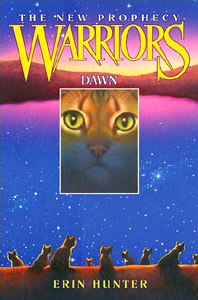
Cover of Warriors: The New Prophecy book 3 |
ISBN: |
0-06-074455-3 |
|
Hardcover, x + 335 + [1] pages, USD $15.99 |
|
| Title |
Starlight (Apr 2006) |
| ISBN: |
0-06-082758-0 |
|
Hardcover, viii + 321 + [1] pages, USD $15.99 |
|
| Title |
Twilight (Sep 2006) |
| ISBN: |
0-06-082764-5 |
|
Hardcover, x + 319 + [1] pages, USD $15.99 |
|
| Title |
Sunset (Jan 2007) |
| ISBN: |
0-06-082769-6 |
|
Hardcover, xi + 303 + [1] pages, USD $16.99 |
|
|
Erin Hunter’s Warriors series of six novels, about four Clans of feral cats living in a (probably) British forest (reviewed in Anthro #4), was so popular that it has been quickly followed up with another six-volume sequel, Warriors: The New Prophecy.
The first Watership Down-style series featured a large number of ‘realistic’ cats, but it focused upon the warrior Fireheart (elevated to Firestar in the last volume), as he rose through the ranks of ThunderClan. Fireheart, his ThunderClan friends, and the other three clans (WindClan, RiverClan, and ShadowClan) had many adventures, but the most dramatic continuing plot revolved around Fireheart’s efforts to save the clans from the heroic but evil warrior Tigerclaw (later Tigerstar) and to reveal his villainy. The series ended with Tigerstar not only exposed but dead, and Firestar recognized as the strong new leader of ThunderClan.
Warriors: The New Prophecy is a much more complex story. It begins with Brambleclaw, Tigerstar’s distrusted son in ThunderClan, getting a dream from StarClan, the spirits of deceased honorable cats of all Clans, telling him to go with a young cat from each tribe (Tawnypelt of ShadowClan, his sister; Feathertail of RiverClan; and Crowpaw of WindClan) to “the sun-drown place” (the coast) where they “must listen to what midnight tells you” of a great danger that threatens all the clans and their forest. The four cats, plus two friends who insist on joining them (Squirrelpaw, Firestar’s daughter, and Stormfur, Feathertail’s brother), end up on an epic quest during which they meet new cat tribes, learn that Midnight is a mystic badger, and are told that the danger is too great to be fought and that the Clans must migrate to a new home to avoid extermination. There are romances and deaths during their quest, and not all the six return. This basically covers the first two books.
Meanwhile, the four Clans are terrified by the cutting down of their forest around them by the ‘Twolegs’ to build a new Thunderpath (highway), who also try to capture as many cats as they can. The questers face hostility when they return months later, but Firestar understands that their old home cannot be saved. The questers lead a desperate, danger-filled exodus to a new home that will be indicated to them by StarClan. New cats come into the story’s focus, notably Leafpaw and Mothwing who want to become medicine cats for their Clans, and Hawkfrost, another of Tigerstar’s sons. Both Brambleclaw and Hawkfrost have become respectable warriors in their Clans, but many cats worry that they are tainted by the same lust for power that corrupted their father. This seems particularly ominous to the reader, who is aware that the ghost of Tigerstar is trying to control his sons through their dreams. The middle two books focus upon the doom of the cats’ ancestral forest, the exodus, and the settlement of their new home in a mountain valley; during which several romantic subplots are developed.
In the final two books, Leafpaw (now ThunderClan’s medicine cat Leafpool) tries with limited success to maintain the spirit of cooperation that grew during the exodus. ThunderClan is devastated by an unexpected disaster, and suspense is developed around whether the other Clans will help or try to take advantage of ThunderClan’s weakness. The supernatural menace of Tigerstar’s influence over his sons is brought into prominence, especially to threaten Brambleclaw’s romance with Squirrelpaw and to taint his motives for his loyal efforts as a ThunderClan warrior.
There is much good about Warriors: The New Prophecy, but on the whole the series is a disappointment compared to the first series. Warriors was focused around a single cat; New Prophecy has too many main characters and changing viewpoints. Warriors presented four Clans who believed in a mystic StarClan, with the stars in the sky representing warriors who have died heroically over the ages, as a religion to inspire and guide them. New Prophecy begins with a scene showing the ghostly cats of StarClan themselves, worrying about the coming dangers to the Clans. This turns StarClan into a reality, which makes their inability—or unwillingness—to provide more specific warnings unsatisfyingly frustrating. Why does StarClan send the six young cats wandering for months to the sun-drown place to get a vitally important message that StarClan could have told them directly in the first place? There are too many dreamtime warnings that do not warn as much as create clearly unnecessary suspense:
Fear stabbed at Leafpool; she dug her claws into the ground to keep herself steady. “What do you mean?”
“There are cats you have yet to meet,” Bluestar told her. “Yet their paws will shape your future.”
That’s no answer. Leafpool wanted to protest, but her respect for the StarClan cats kept her silent. (Sunset, pgs. 102-103)
The expanded setting of New Prophecy is even more confusing to readers who try to figure out whether the cats are in Britain or North America. We learn that their forest is reasonably near some coast, as well as a dangerous mountain range which contains a “huge tawny-colored cat”, Sharptooth (a cougar?), that eats regular cats. The original six books contained four pages of excellent maps showing the warriors’ forest and the location of the four Clans in it. New Prophecy reprints those same maps in the first three books, and does not replace them with new maps of the warriors’ new home until Book 4, Starlight. This is reasonable because the mountain valley does not enter the story until then, but the first two books concentrate on the quest to the coast and back and are ‘off the map’, so the older maps are pretty but meaningless here. Warriors was well-paced, while large parts of New Prophecy (notably most of Twilight, including its way-too-dramatic climax) seem more like deliberate padding to fill out six books. Some of the new deeds that the cats accomplish, such as figuring out how to harmlessly spring human traps, may strike some readers as going beyond a reasonable fantasy extension of realistic feral cat behavior.
Perhaps worst of all, Warriors was brought to a definite conclusion with no questions left unanswered. New Prophecy keeps adding more cryptic elements (“Before all is peaceful, blood will spill blood, and the lake will run red” becomes an ominous mantra repeated throughout the series) and hints of new dangers right up to the top of its last page. This makes the final paragraph—“It’s over,” Leafpool told them quietly. She squared her shoulders and turned her face to the rising sun. “It’s over, and peace has come.” (Sunset, pg. 303)—more of a bad joke than a happy ending. Presumably readers are not supposed to feel frustrated by all the questions left open because the next page is an advertisement for the first in a third series of six more novels, Warriors: Power of Three, which is to begin in April 2007. Clearly the authors (Erin Hunter is a pseudonym for the British team of Kate Cary and Cherith Baldry—see the “special thanks to” dedication in each book to learn who is its real author) have a good thing going with Warriors, and they intend to continue it for as long as it is commercially viable.
P.S.: Only a few days after this review was finished, this press release came out indicating that some of the questions left unresolved will not be answered in Warriors: Power of Three but in a separate comic book/manga series:
“TOKYOPOP and HarperCollins Set to Bring Erin Hunter's Bestselling Children's Series to Manga Format
WARRIORS: The Lost Warrior!
-Manga Trilogy Marks First Release in Companies' Co-Publishing Deal-
-Chronicles Never-Before-Told Tale of Beloved Character 'Graystripe'-
-Series Launch Features Erin Hunter's Special Note to Readers-
Los Angeles, CA (Feb 5, 2007)- TOKYOPOP, the leader of the Global Manga Revolution and HarperCollins Publishers, one of the top English-language publishers in the world, are pleased to announce the May 2007 release of Warriors: The Lost Warrior, the first graphic novel series to be launched under the two companies' recently announced innovative co-publishing deal.
Drawn from Erin Hunter's #1 nationally best-selling Warriors books, The Lost Warrior features a very special note from the author to Warriors fans. Warriors: The Lost Warrior manga series, created by Dan Jolley and James Barry, tells the untold tale of the feline hero Graystripe: his life with humans and his ultimate quest to be reunited with his clan.
Graystripe's story in the manga series bridges the gap between Hunter's The New Prophecy and the next installment of the Warriors novel series Power of Three.
[…]
The Lost Warrior is the first of a trilogy. The second book will release in December 2007.”
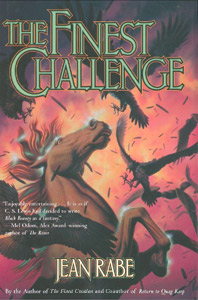 |
|
|
| Title: |
The Finest Challenge |
| Author: |
Jean Rabe |
| Publisher: |
Tom Doherty Associates/Tor Books (NYC), Sep 2006 |
| ISBN: |
0-765-30822-3 |
|
Hardcover, 317 pages, USD $24.95 |
|
|
Kalantha and Meven have been reunited and are about to stop the war, but Gallant-Stallion is lame in the royal stables and unable to protect them from the latest plots of the evil falcon Ninéon and her avian and human puppets…
Confused? Well, this ‘novel’ is actually the third volume of a single novel. Do not read it on its own. Start with The Finest Creation and The Finest Choice (reviewed in Anthro #5) before you begin this one.
In the fantasy world of Paard-Peran, the good gods have created a special class of divine horses to serve as guardian angels to especially important humans. Disguised as normal horses, these Finest guard their humans and subconsciously nudge them to be virtuous, kindly, good, and so forth. However, the evil gods of Paard-Peran have selected vicious birds to be their counterparts, tempting men to be brutal, cruel, greedy, and filled with a lust for power. In the first two novels, an enthusiastic young Finest, Gallant-Stallion, is assigned to be the secret mentor of the juvenile prince and princess of Galmier, Meven and Kalantha. When birds slaughter the rest of the wedding party they are riding with, Gallant-Stallion (known to humans as Rue) saves the children and surreptitiously protects them during several months in hiding. Gallant-Stallion assumes at first that Prince Meven is his primary charge with the younger Kalantha as a tagalong; but by the end of The Finest Choice it seems clear that Kalantha is his real responsibility. The strong-willed girl learns that her horse can speak telepathically with her. The weaker-willed Meven, now Galmier’s youngest king, allows himself to be pressured into starting a bloody war of conquest, which Kalantha is determined to stop.
As The Finest Challenge begins, Meven, sickened by the gory realities of warfare, agrees with Kalantha. But the birds, now led by the falcon Ninéon, are sure that they can sway him back to keeping the war going if they can just get him away from Kalantha’s influence. The birds make an early appearance in this volume:
Kalantha decided it was an argument she couldn’t win and headed for the palace. Neither she nor Meven saw a thin crow hovering above the largest tent-infirmary. It flew toward the palace, reaching it long before Kalantha. Perching on the north crenelated tower, it cawed to a dozen blackbirds, which were quick to join it.
“Ninéon,” the crow said. “I must find Ninéon and tell her of King Meven’s intentions.”
“Tentions?” a big cowbird asked.
“Intentions, plans,” one of the blackbirds corrected. “What plans, Arlee?” Not all of the blackbirds were capable of speech, but this one was and the crow knew her to be overly curious. “What plans does the man-king have? Are they interesting plans?” (pg. 25)
Meanwhile, Gallant-Stallion has assumed it is safe to leave his humans for a moment and return to the Finest Court, the horsy Heaven, to be cured of the lameness he suffered protecting Kalantha and to report to the equine nobility at the Shimmering Paddocks. The Finest Court is an idealized pasture with every convenience for horses. Rabe seems to have populated it with every obscure breed of horses that she could get the names of:
He tossed his head back, his mane whipping in the air. Then he struck out along the stream toward the lowlands, where he knew other Finest would be found. He hadn’t traveled far before he came to a landais and a konik, both grazing on wild white clover. The landais was impressive, an old breed, shiny black with a small head and a stately profile. Muscular, it had sloping shoulders and pronounced withers. The konik was the size of a pony, looking tough and hardy, with dark brown dorsal and wither stripes cutting through its chestnut coat. Its small ears twitched at Gallant-Stallion’s approach.
“Nightcrest.” Gallant-Stallion acknowledged the landais, having met that Finest on a few previous visits. Then he looked to the konik.
“I am Fastrotter Summerfield.”
“And you are called Gallant-Stallion, correct?” the landais said. “I remember you, Steadfast’s apprentice. You have been gone from these lands for a long while.” (pg. 30)
The Shimmering Paddocks came into view on the other side. Locust trees and clumps of birch trees pierced the flat land, and pink-flowered bunchberries bordered it and lent an ambrosial scent to the air. In the sunlight the tall grass and wildflowers glistened and stretched as tall as the hocks of the ponies in the assemblage. More than one hundred Finest were gathered before the Court. Gallant-Stallion had not seen so many in one place before.
[…] Gallant-Stallion noted tarpans, shaggy-coated bali ponies, thick-bodied bardigianos, heavy-headed bashkirs, diminutive bataks, attractive falabellas and long-maned fells. Pindos ponies were side by side with halflingers. (pgs. 31-32)
Kalantha is separated from both Gallant-Stallion and Meven early in the book. Chapters switch back and forth between Kalantha escaping from human villains and searching for her horse; Gallant-Stallion breaking out of the palace stables and looking for Kalantha; Meven riding towards the front, insecurely determined to end the war despite the disapproval of his commanders; and the human and avian villains. Most of the talking animals appear in the chapters with Gallant-Stallion or with the birds:
The girl was in a hurry. The girl was terribly, terribly frightened.
Gallant-Stallion looked down and saw a mouse at the edge of a mound of hay outside the stables.
I understand fear, big horse. The girl ran into the horse-house, then ran out.
A girl with red-brown hair and green eyes? Gallant-Stallion asked him.
The mouse raised up on its hind legs, whiskers twitching and black eyes wide. Brown boots, dirty legs, smelly. I did not see her eyes or hair. Too high for me to look. I worried that she would step on me as she ran. (pg. 109)
Valane [Ninéon’s sparrow deputy] understood people better now. Ninéon had done something to her to make her smarter and cleverer. The water in the murky pond that the sparrow had initially railed against was the catalyst. And twice when Ninéon was elsewhere the sparrow drank from it again. Such a smart, resourceful bird!
[…] Valane had no desire to take Ninéon’s place, as she’d heard the tales of Ninéon slaying Eyeswide, an owl said to rule all the birds of the world. From the sparrow’s observations, the ones in power were the ones facing the greatest risk—from enemies seen and from those not yet discovered.
No, Valane would be content to work from the shadows, but if only she could do so with more wiles and speed! (pg. 210)
New talking animals with important dialogue include two more Finest horses, Honest-Stormchaser (Cornsilk) the iomud and Shimmermane (Nobleborn) the noriker; Stump the bloodhound; and two of Ninéon’s more intelligent henchbirds, Valane the sparrow and Arlee the crow. The separate stories all converge eventually for a climax that is mostly predictable but does have some surprises.
Spoiler warning: The Finest Challenge ends with a satisfying conclusion to the trilogy, but a surprise Epilogue leaves a plot thread as thick as a hawser cable dangling for a potential continuation of the series.
Clem Martini, a professor of drama at the University of Calgary, has written this trilogy about crows for young adults, recommended for ages 10 - 13. The first, The Mob, has been shortlisted for several juvenile literary awards. Fans of stories like Watership Down which concentrate upon one species, combining realistic depictions of the animals and their behavior with an imaginative species vocabulary and religion, featuring characters anthropomorphized just enough to make them easily-identifiable individuals, should enjoy this series, although it is a bit juvenile for adult readers. (For a similar but more mature novel, although with ravens instead of crows, Raven’s End: A Tale from the Canadian Rockies by Ben Gadd is recommended.)
The trilogy is more like a single novel with a two-volume sequel. The Mob tells of the annual Gathering of the great Kinaar Family of Crows, six clans totaling about eight hundred birds, as narrated by Kalum, its elderly Chooser. Dramatic and tragic events happen, centered around the rebellious young male Kyp ru Kurea and female Kymmy. At the conclusion, both young Crows and the Family seem to have learned lessons and come to a satisfactory understanding. But The Plague begins with a great plague which kills most of the Kinaar. Kyp emerges from his fever to find that Kalum has been brutally murdered and Kym kidnapped. This middle novel is occupied almost entirely with Kyp’s epic quest from Canada’s great plains to the East Coast to find survivors of the Plague, and to rescue Kym. It leads right into The Judgment, in which Kyp, Kym and their new Family of younger Crows flee along the Atlantic and Gulf coasts of North America to the Rio Grande and then northward up the central great plains (despite the pretty but inaccurate map that puts the great plains in Southern California), barely ahead of the Collection, the gigantic flock controlled by Kyp’s dictatorial enemy Kuper, to the Urkana, a legendary winter roost of over a million crows. There Kyp and his rival fight for recognition by the Crow elders to determine whether Crows should continue to live traditionally, scavenging as independent birds, or whether they should become parasites begging food directly from humans—or, more dramatically, use their great numbers to mob humans and take whatever they want.
Although the Crows do not use humans’ geographic names, Martini’s descriptions are clear enough that readers can recognize that Kalum and his companions come from the West Coast through the Rocky Mountains, and that the Gathering is somewhere in the northwestern great plains. Kyp’s search for Kym, gathering scattered survivors of the Plague along the way, leads to the East Coast and south to New York City, where they roost for the winter in Central Park. The living among humans seems easy, but this is where Kyp realizes that such a life can lead to the extinction of the Crows’ independence:
“Kyp stared a long time at the pigeons, listening to their soft, relentless thrumming. ‘That’s what we could become if we stayed among humans, stealing from them as Kuper wants. Eventually. Just another kind of pigeon, pecking in and out of the human’s paws. We have to escape that.’” (The Plague, pg. 196)
The description of hundreds of Crows roosting in one large tree, and of Kyp’s enemy collecting a rival flock of sixty to seventy thousand Crows, may seem like implausible exaggerations. But in fact, the area of northern New York around Ithaca and Auburn has been ‘plagued’—that word is frequently used in news reports—with an annual migration of crows estimated at from 60,000 to 125,000 for the past two decades. So the size of the great flocks of crows is not unrealistic.
Martini’s corvid religious fables, in the style of Native American creation myths as so many authors since Richard Adams have invented for their animal species, are nicely done:
Long ago, Great Crow was large as a tree, and trees were large as mountains, and mountains stretched to the stars.
At the talon end of the mountains, in the most remote hole, lived Badger. Not Badger as we know badgers now. This was First Time Badger—solid as a hill, long clawed and always hungry. (The Mob, pg. 28)
Unfortunately, it is when Martini gets original that his writing develops minor problems. His Crow language, giving all the Crows names starting with ‘K’, is superficially clever but overly confusing in practice:
‘This particular Gathering has been unlike any other I have ever attended. The six great Clans of the Family Kinaar—Kemna, Kelk, Koorda, Kurea, Kark and Kush—have advised me, and I alone have learned everything that surrounds these tragic recent events.” (The Mob, pg. 10)
There is a list on pages 233-234 of seventy-two names like Ketta, Karl, Kora, Kesky, Klara, Kaleb, Keefar, and Kakyna. The mind boggles. (There are a few exceptions, notably the European crow Erkala.)
The Mob is narrated by the elderly (and garrulous) Kalum:
“Now, you all know me, or at least have heard of me. My name is Kalum ru Kinea ru Kinaar and I am old. Old. It’s thirty-eight springs that I’ve gripped branch, thirty-eight springs that the land has weighed my shadow, thirty-eight springs I’ve tested and bested gales, spread wings and made my way north in thirty-eight tiring, trying, shoulder-wrenching migrations.” (The Mob, pg. 9)
Kalum is brutally killed at the beginning of The Plague. This is certainly unexpected; but it leaves the new narrator of The Plague annoyingly anonymous until he is finally identified on page 59.
All three novels place the crows into situations of great danger which they survive only by ‘inventing’ new tricks (basically copying human actions) that are unnatural to their species. This deus ex machina is not uncommon for fantasy adventures featuring predominantly ‘realistic’ animals, but once each in all three novels is too much. By The Judgment it is overly predictable.
It would be unfair to emphasize only the novels’ flaws. A major strength is that, while the characters’ names may be overly similar, their personalities are sharply individualistic. The reader can easily tell who is talking without reference to their names. And the fast-paced narrative is constantly dramatic.
Feather and Bone: The Crow Chronicles never slows down. To repeat, this trilogy for middle-school readers may be a bit lightweight for hard-core anthropomorphic literary fans, but it is an enjoyable and fast read that should not be ignored.
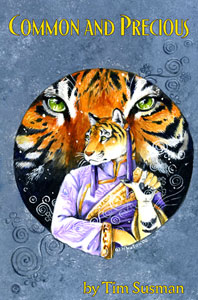 |
|
|
| Title: |
Common and Precious |
| Author: |
Tim Susman |
| Illustrator: |
Sara Palmer |
| Publisher: |
Sofawolf Press (St. Paul, MN), Jan 2007 |
| ISBN: |
0-9769212-9-4 |
|
Trade paperback, viii + 299 +2 pages, USD $17.95 |
|
|
Editor’s note: In addition to being available from Amazon.com, you can also buy Common and Precious directly from the publisher, Sofawolf Press.
Common and Precious is the first novel, although the third book, in Susman’s “Stories from New Tibet” series. The first two, Breaking the Ice (2002) and Shadows in Snow (2004), edited by Susman, were anthologies of five or six original short stories by Susman ‘and friends’ (other authors invited to write a story set on his world). Breaking the Ice set the theme of New Tibet as a bleak, frozen colony planet inhabited by thick-furred ‘morphs (arctic foxes, bears, wolves, etc.) who were brought there as lower-class wage slaves, whose only goal is to escape back to their home worlds (or any warmer planet) as quickly as possible. Now, in Common and Precious, we meet the first peoples who are satisfied to call New Tibet their home—although some want improvements made.
Everything is perfect as far as Tiger Barda is concerned. The ruthless President and CEO of TeraMine, one of the largest industries on the planet, is the most powerful person on New Tibet—at least, nobody would dare tell him otherwise:
On this day, his seven-foot frame was elegantly sheathed in a tailored dark blue vest with gold trim, a formal white shirt left open at the neck, and dark blue pants to match the vest. His face was sleek, like most of the Bengali tribe, without the prominent cheek ruffs of other tribes, and he wore gold-rimmed eyeglasses that sat on the bridge of his nose without any other visible means of support. Given the icy glare that was Barda’s favorite expression, perhaps his eyeglasses dared not fall. (pg. 10)
[…]
Jura froze, then looked down at his lap and folded his paws and ears down. Barda continued to stare at the young tiger until he was sure Jura was about to soil himself. “I am sure,” he said slowly, “that you can report to me some violation of company policy sufficient for [a troublesome employee’s] dismissal.”
The young tiger worked his throat, but no sound came out. He nodded.
“I expect the report on Passa Nerim’s desk tomorrow morning.”
This time, Jura managed a scratchy, “Yes, sir.” (pg. 11)
Everything is almost perfect as far as Barda’s seventeen-year-old daughter Melinda is concerned. True, the spoiled girl expects little more than a life of boredom as the trophy wife of whatever influential suitor her father chooses for her, but this is the natural fate of an aristocrat in her position. If her father is overly protective, this seems natural considering the unexplained disappearance of her mother eight years previously:
The world was dangerous, as her father had always told her. She wondered if he knew what had happened to her mother; he was no more willing to talk than Sashi [her lemur personal servant] was. Recalling the fights she’d heard, she thought of the stories she’d read about abusive husbands, but her father was nothing but loving to her. He did press a little too hard to get her to accept Passa Gerrar, but she could live with that. After all, she would have to marry someone eventually. Her father was just trying to make sure she had the best husband on New Tibet. He wasn’t cruel. (pg. 22)
Those who find New Tibet far from perfect include Shamil Deloup, the wolf head-nurse/administrator of a poverty-ridden slum hospital, and her staff/friends:
Wolf help us, she thought. It’s going to be a cold night. The roof had broken again, and when she turned to look inside the room, she saw snow drifting down to the floor inside the room as well. She started to catalog the things she’d need in her head: prefab panels they could get, or at least pieces of them. (pg. 5)
Shamil’s husband and some friends, former radical activists, decide the best way to get money to improve the hospital is to kidnap Tiger Melinda for a million credit ransom. Shamil reluctantly agrees, not just for the money but because she has a personal reason for wanting to meet Meli. The kidnapping is successful despite unexpected violence, until the Shivers deal themselves into the plot.
Meli’s father had warned her about the Shivers, told her that other than the Vishons, they were the worst, most dangerous people on New Tibet, the scourge of honest businessmen. They were a powerful crime syndicate run by a ruthless leader, and because their leader was a tiger, her father respected the Shivers’ power. […] “beware of any wolves who look tough and act important. By associating with tigers they puff themselves up, but that doesn’t mean they’re not dangerous.” (pg. 81)
Wolves haunted her memories. White wolves, black wolves, all ethereal and sinister. Shamil was the only wolf she’d met recently who seemed at all normal. “You knew that wolf in white,” she said.
“Yes.” [Jac] met her eyes, then looked toward the doorway of the house.
“And you’re afraid of him.”
“Yes.” He said that without much emotion. “Everyone who knows them is.”
“Them? There was another one,” she remembered. […]
“Yes. They trained under the black demon. They’re not demons, but they’re as close as wolves can get. They call each other Bright and Night. One wears white and the other wears black.”
“Bright and Night?”
“From what I hear, they’re not quite right in the head. But they’re awfully good at what they do. All the Shivers’ best assassins are wolves. The tigers just don’t like fighting and killing as much.” (pgs. 102-103)
The Shivers want Meli for reasons of their own. They pursue her and her kidnappers from the hospital into the one place on New Tibet that even the Shivers fear. The novel is in two parallel stories: that of Meli, who slowly learns while in hiding how the common people of New Tibet live, and that of Barda, who becomes convinced that the way to get Meli back is to become even more ruthless than the Shivers are.
The most interesting characters in Common and Precious are those with the most varied personalities, such as Melinda, who discovers the richnesses within the poverty of the lower classes and the dying, and the full meaning of the ‘morphs’ Circle religion; Shamil, who understands compassion and knows what happened to Meli’s mother; Jac, the arctic fox organizer of the kidnappers’ defenses who becomes Meli’s bodyguard; Cab, the jaunty weasel driver who specializes in impossible escapes; and Jonathan, the blind hare doctor of Ghost Town, among others. The title comes from a motto painted on a wall at Shamil’s hospital:
LIFE IS COMMON
LIFE IS PRECIOUS
It is when Meli realizes what this really means that she truly rescues herself.
Common and Precious is the best of the New Tibet stories so far. It is the longest and has the most complex plot. It has some of the best action scenes, and Cab has some of the best dialogue. A two-page Introduction gives some historical background at last to the interstellar anthropomorphic civilization. (The previous books just presented New Tibet as a planet populated with thick-furred funny animals). There are ten attractive full-page illustrations by Sara Palmer.
Most importantly, its mood is upbeat and its cast is much easier to empathize with. Even the Shivers act with a sense of crude enthusiasm rather than despondency. Where Breaking the Ice is about losers who are desperate to flee offworld, Common and Precious is about those who are proud to call New Tibet home and are ready to work to make it a better place. They may not all agree on what the best way is, which is what provides the drama, but their determination ensures that the story never becomes mired in depression. If you are unfamiliar with the ‘Stories from New Tibet’ series, Susman’s Common and Precious is the best starting point.
Editor’s note: In addition to being available from Amazon.com, you can also buy All the Newshounds Fit to Print directly from the author.
Thomas Dye is the latest webstrip creator to switch to self-publishing his reprint collections through Lulu.com. All the Newshounds Fit to Print, the seventh and final collection of his recently-completed Newshounds strip about TV news station KPET, run by human owner/manager Lorna Dilbeck and her staff of seven pets (five dogs, a cat and a rat), returns to the 81/2" x 11" format of his self-published first volume, bookending the five 7" x 5" collections from Plan Nine Publishing between 2000 and 2005.
The blurb for this volume—The ultimate collection of Thomas K. Dye's internet-based Newshounds comic, telling the Newshounds' story from beginning to end.—may be misleading, however. That’s ‘ultimate’ as in ‘final’, not a complete compendium of the entire strip. All the Newshounds follows directly after Plan Nine’s last volume, Surgery in the Park, containing the strips from September 19, 2003 through October 12, 2004. All the Newshounds has the strips from October 13, 2004 through the conclusion on December 6, 2006. Unlike, say, D. C. Simpson’s Ozy and Millie Lulu.com collections which duplicate and replace the earlier Plan Nine reprints, all of Dye’s Newshounds collections from Plan Nine will stay in print. The reader who wants to have the whole Newshounds strip in book form will need all seven collections.
What the “from beginning to end” in All the Newshounds means is that Dye has created a new 22-page introduction for this volume. Newshounds began on November 1, 1997 with KPET up and running. This introduction consists of a seven-page backstory showing how Lorna first met her pets and came to start KPET with them as her staff, plus a 15-page synopsis of the highlights from 1997 through late 2004. There are also an Extras section of outtake strips that did not fit into the regular continuity, and six pages of Author’s Commentary, at the rear of the book. So unlike the Plan Nine collections, which start and end abruptly, All the Newshounds gives you a new beginning, a summarized middle, and the complete ending of the strip. It is probably the best single-volume complete story of Newshounds that there will ever be.
Newshounds began as a series of gag-a-day strips built around topical news events, both real and exaggeratedly fictional, and how the KPET staff reacted according to their individual personalities. Lorna Dilbeck (human) was the harried manager occupied with the practical details of keeping a tiny independent news station on the air. Renata Fayre (cocker spaniel) and Wolfram Blitzen (husky) were the photogenic Action News anchors. She was genuinely interested in being a serious telejournalist (with many frustrations as a dog trying to compete in the world of human reporters), while he was primarily concerned with looking good on camera in both his fur grooming and wardrobe. Sam Shepard (Labrador), the sportscaster, was the mouthpiece for parodies about aggressively macho right-wing attitudes, while weather forecaster Alister Katt was his leftist counterpart, always hysterically trying to persuade Lorna to cover (and favorably play up) every ultra-liberal movement. Kevin J. Dog (golden retriever) was KPET’s long-suffering cameraman and general handyman. Ferris the Rat (discovered infesting the building that became the KPET station; Lorna was talked into keeping him on as the janitor instead of calling the exterminators) stood for mindless acceptance of trendy fads; one of Newshounds’ most popular running gags was Ferris’ adulation of TV actress Tori Spelling. The last regular cast member, field reporter Rochelle O’Shea (collie), first appeared much later as a temporary replacement for Renata when the latter was briefly incapacitated. Rochelle is a classic example of an intended minor character who quickly grew into a major permanent role, to the author’s surprise.
As Newshounds evolved, the cast’s personalities grew more complex and the strip developed longer and more in-depth episodes to display them. By the time of All the Newshounds Fit to Print, many storylines had already become established: Wolfram’s romantic passion for Rochelle; KPET’s rivalry with the larger and all-human KRVL: KPET’s financial obligation to Virgiltech, the corporation started by Lorna’s flaky half-brother (which was no problem as long as Virgil ran it, but which became a major problem after he was forced out by an unsympathetic new management); the unwanted obsessive romantic pursuit of Renata by Hal O’Peridol, the dog CEO of polluting Sunflower Chemicals; and Alister’s gradual realization that he was gay, and his troubled relationship with Nigel, an overly-insecure young cat; among others. In All the Newshounds, these storylines are brought to their final resolution; most notably with Wolfram’s proposal to Rochelle, their marriage, and her pregnancy, and with Sam’s development of some mental depth (he no longer automatically accepts everything George Bush does as right).
Another sequence will be especially appreciated by transformation fans. Lorna is given anesthetic for a tooth extraction, and imagines that she is a dog and her staff are humans. This leads to a crisis when she is declared incompetent and her sleazy, animal-hating father tries to sell KPET to its enemy KRVL. More significantly, the strip becomes drawn from Lorna’s viewpoint, so readers get to see her as a dog and her pets as people for about a month and a half’s worth of strips until she recovers.
The climax, when Lorna must seriously consider closing down KPET and what this will mean to her animal staff, is one of the best “life doesn’t end; it just goes ahead in different directions” resolutions that any strip has ever had. If you have not read Newshounds before, All the Newshounds Fit to Print is an excellent single-volume presentation of the entire series. Get it.
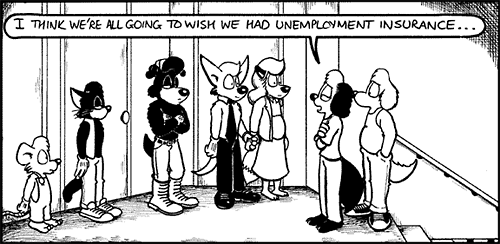
Group shot of Newshounds’ non-human cast, from the 20 Nov 2006 strip
Anthropomorphic books for review should be sent to Fred Patten, at:
Golden State Colonial Convalescent Hospital, 10830 Oxnard Street, North Hollywood, CA, 91606


 Tales of the Fur Side contains thirteen stories and nine poems. Each is illustrated with the picture(s) upon which it is based. The stories and poems are bookended by a Bob and the Devil prologue and epilogue, in which two identical old men both named Bob, obviously God and the Devil, play games of chess for the fate of mortals; but this time, “We play animalkind in stead [sic.] of mankind like in the other games.” (pg. 12)
Tales of the Fur Side contains thirteen stories and nine poems. Each is illustrated with the picture(s) upon which it is based. The stories and poems are bookended by a Bob and the Devil prologue and epilogue, in which two identical old men both named Bob, obviously God and the Devil, play games of chess for the fate of mortals; but this time, “We play animalkind in stead [sic.] of mankind like in the other games.” (pg. 12)


